| ID |
Date |
Author |
Subject |
|
11
|
Sat May 2 19:32:08 2015 |
AE | transfer data AIDA->BRIKEN |
A test program for online data transfer is available in aidas1 PC at:
/homes/npg/aev/AIDAbriken/AIDA-jorge-san.exe
no arguments are required to run it from command line |
|
10
|
Sat May 2 03:52:14 2015 |
J.L. Tain | 3He tube description |
3He tube drawings and technical details:
RIKEN, UPC, GSI, ORNL-1, ORNL-2 |
| Attachment 1: He3_GE_30cm.pdf
|


|
| Attachment 2: He3-252248.pdf
|



|
| Attachment 3: 1inch3He.pdf
|
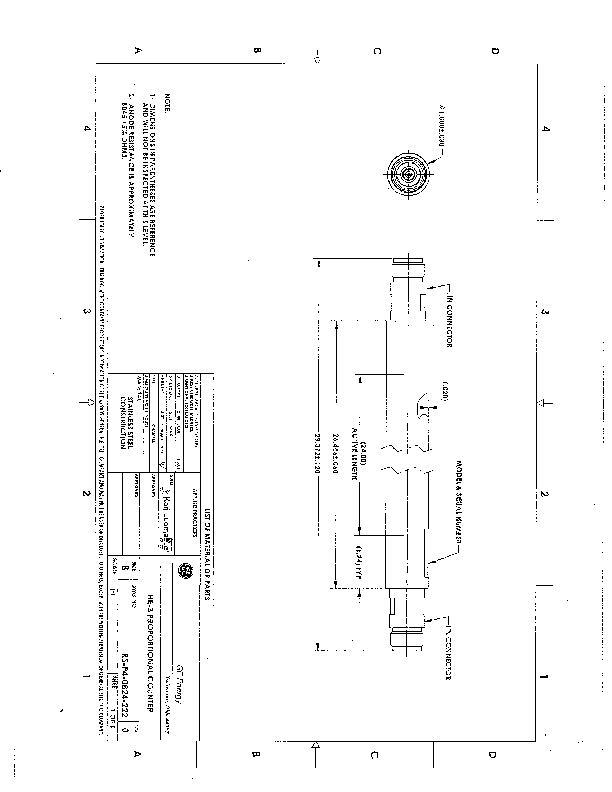

|
| Attachment 4: 2inch3He.pdf
|
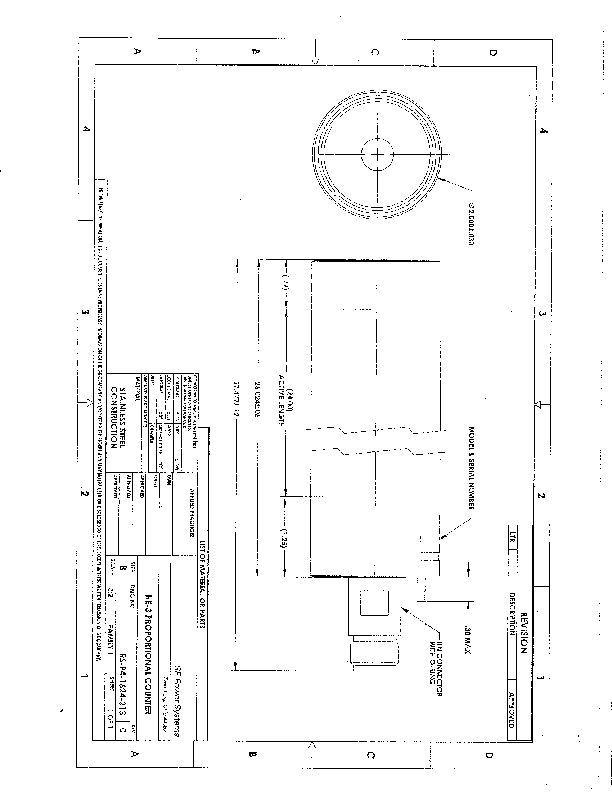
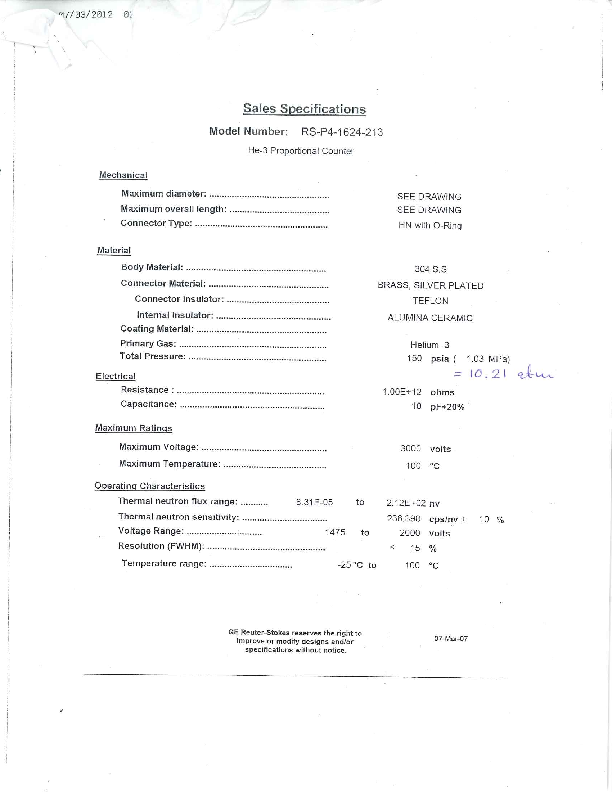
|
|
9
|
Mon Apr 27 10:18:21 2015 |
K.Gabor S.Nishimura J.Agramunt | ORNL 3He tube at RIKEN |
|
| Attachment 1: photo-3.JPG
|

|
|
8
|
Mon Apr 27 04:40:43 2015 |
G. Kiss, J. Agramunt | neutron background at Eurica |
Based on an about 8h long background measurement, the neutron background at the Eurica site was found to be about 0.006 neutron / sec (in the Riken tubes) and 0.019 neutron / sec (in the ORNL tubes). The beam was OFF. |
|
7
|
Sat Apr 25 08:25:42 2015 |
G. Kiss, J. Agramunt | BRIKEN Test setup |
Altogether 16 tubes are mounted for the parasitic detector test (see the attached photos):
- two tubes (belonging to RIKEN) are in a 10 cm x 10 cm x 30 cm polyethylene matrix inside Eurica, the distance from AIDA is about 30 cm
- 12 tubes (belonging to RIKEN) are in a 20 xm x 30 xm x 30 cm matrix, outside (below) Eurica, at the closest possible place to AIDA, the distance is about 60 cm
- further two tubes (ORNL) are at the bottom of the Eurica support, about 1.2 m from the AIDA Silicon.
Furthermore, spectra measured using a 252Cf source is attached to this report, too (Jap1Cf-RIKEN tube, Us1Cf-ORNL tube). At the moment a background measurement is running. |
| Attachment 2: P1120023.JPG
|

|
| Attachment 3: Jap1Cf.pdf
|

|
| Attachment 4: US1Cf.pdf
|

|
|
6
|
Wed Feb 25 07:38:42 2015 |
A. Estrade J. Agramunt | Usage of synchronization test programs |
In order to access to the synchronization test, we prepare two programs in the PC briken1 ( 10.32.6.54).
To Launch the processes, in a terminal type: DataSink -i 3
In other terminal type SynCheck
By default this preform a test with difference RIBF-BRIKEN and AIDA-BRIKEN.
In case of BRIKEN is not running, the option "SynCheck -M 1" perform de differences AIDA-RIBF and BRIKEN-RIBF, and "SynCheck -M 2" RIBF-AIDA and BRIKEN-AIDA
AIDA Data Relay:
The programming transmitting the data from AIDA to the DataSink includes an intermediate filtering step. This selects only correlation scalars from one module (and possibly ADC values from one channel in that module).
To run the program from aidas1 PC:
DataRelayFilter -n 10.32.6.54 -p 10307 -I 2
"-I 2" selects ID 2 as the one for the AIDA data stream, which must correspond to the one expected by the DataSink in the briken1 PC.
The attached screenshot show the terminal when running the code in verbose mode (-v 1), and also sending the ADC energy of the pulser in channel 10 of NNAIDA11 (adc ~38600 ch). This was for random pulser; for a fixed pulser delta will show constant value of delta (timestamp difference between consecutive correlationpulses).
|
| Attachment 1: 15.png
|

|
| Attachment 2: DataRelayFilter_terminal.png
|
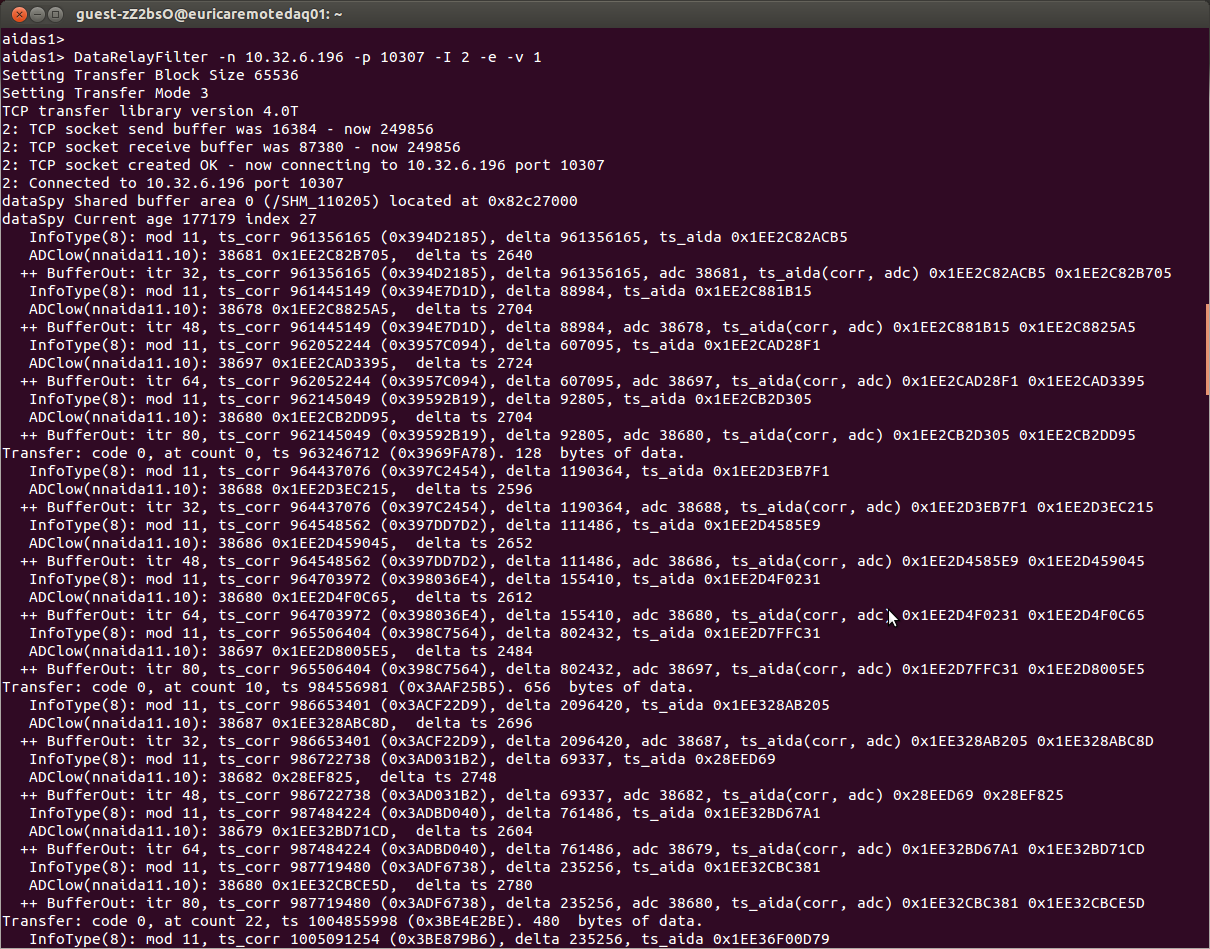
|
|
5
|
Tue Feb 24 09:34:54 2015 |
J. Agramunt, H. Baba, A. Estrade | [DAQ] DAQ correlation test |
We have performed a successful test of the integration of independent DAQ systems based on a correlation
scalar counted from a common clock signal. The principles of the integration method are described in the
following AIDA elog entry: https://elog.ph.ed.ac.uk/AIDA/29
The configuration of the setup we used in the RIKEN test is described by the attached figure:
DAQcorrelation_diagram.pdf. The chosen solution was to use a 25 MHz clock generated by the MACB modules of
AIDA, which was distributed to the other two systems by a SIS36/38xx module in the BRIKEN VME crate (a
slightly modified versio of the method proposed by PCS in AIDA Elog#29).
The correlation can be monitored online using the MIDAS DataXfer and DataSpy toolkits
(http://npg.dl.ac.uk/MIDAS/DataAcq/Data.html). Each system operates a DataRelay program that sends a data
stream consisting only of IDs and time-stamps to a common DataSink (this requires a DataRelay code that
does
some filtering of the raw data). The scheme is shown in the attached diagram (DAQsoftware.pdf).
The DataPeek_Merge and SyncCheck codes use C++11 for parallelization of tasks, which is a helpful feature
to
improve the efficiency of finding coincidences between the correlation pulses. Thus, the code will not
run
in PCs with any Linux version. For example, it requires version 7 of ScientificLinux, which installed in
the
PC being used for BRIKEN DAQ control that will stay at RIBF for the time being.
++ SYNCHRONIZATION RESULTS ++
The figure correlation_25Hz.png shows a correlation plot for the BRIKEN+RIBF+AIDA running with
correlations
done by a pulser at 25 Hz. A large fraction of the pulsers appear in the double-coincidence plots (top
row;
same plots, except the 'Partial' one is automatically cleared every ~10seconds).
The bottom plots show the pair-wise correlations between BRIKEN and RIBF or AIDA. BRIKEN was defined as
the
'master' in this test, but current version of the program is flexible to select any stream as the master
one.
The second figure (correlation_random.png) shows the same test, but using a non-periodic pulser to trigger
the correlation scalar. We observed the same level of synchronization (peaks look broader because of the
zoom level). |
| Attachment 1: DAQcorrelation_diagram.pdf
|
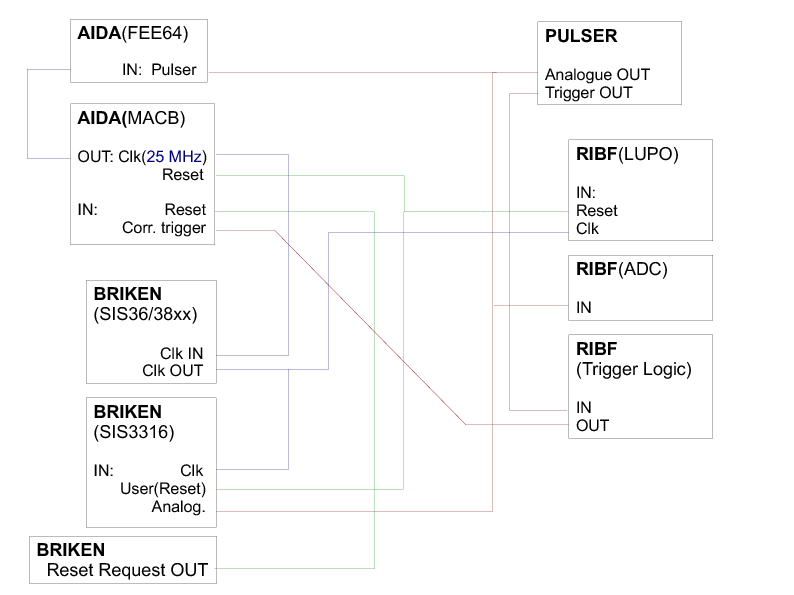
|
| Attachment 2: DAQsoftware.pdf
|
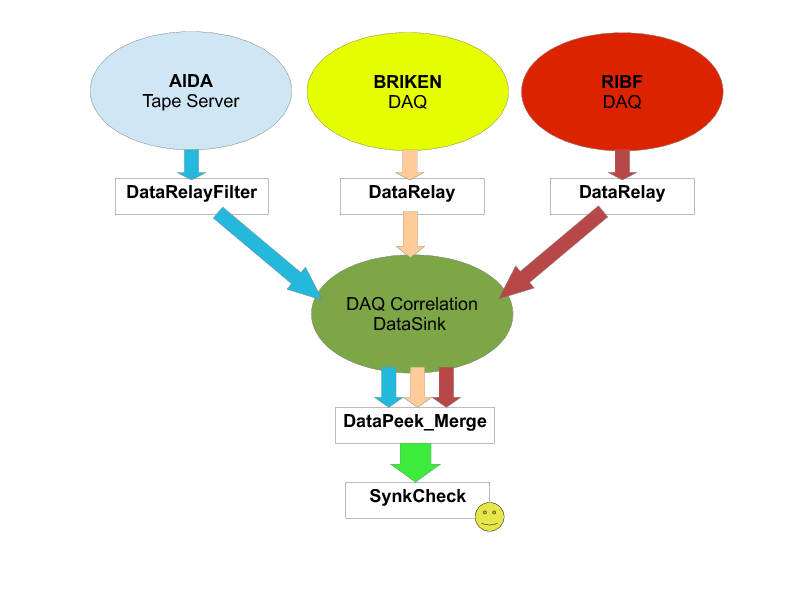
|
| Attachment 3: correlation_25Hz.png
|

|
| Attachment 4: correlation_random.png
|
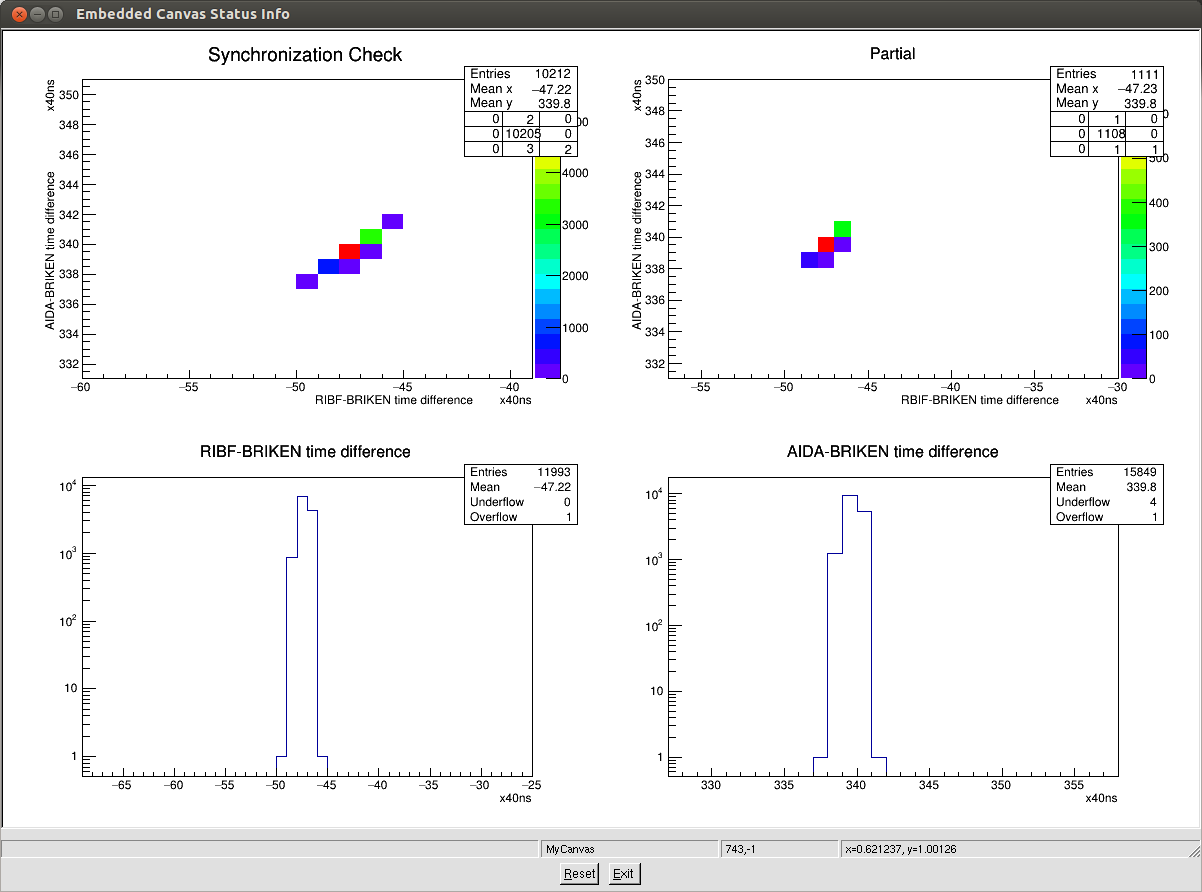
|
|
4
|
Mon Feb 16 00:29:00 2015 |
Gabor KISS | Polyethyelene |
The polyethelene arrived at RIKEN. Except 4 neighboring holes (located at the inner ring) the alignment is OK. |
| Attachment 1: bottom1.JPG
|

|
| Attachment 2: small2.JPG
|

|
|
3
|
Fri Oct 31 12:58:49 2014 |
Robert Grzywacz | Entry test - preamps |
Here is a picture of one of our Mesytec preamplifiers. We have located all seven of them.
They have 16 input channels and a common SHV per board.
<p> <a href="141031_125516/24.png?lb=BRIKEN"><img border="0" alt="24.png" src="141031_125516/24.png?
lb=BRIKEN&thumb=1" name="att0" id="att0" /></a></p> |
| Attachment 1: 24.png
|
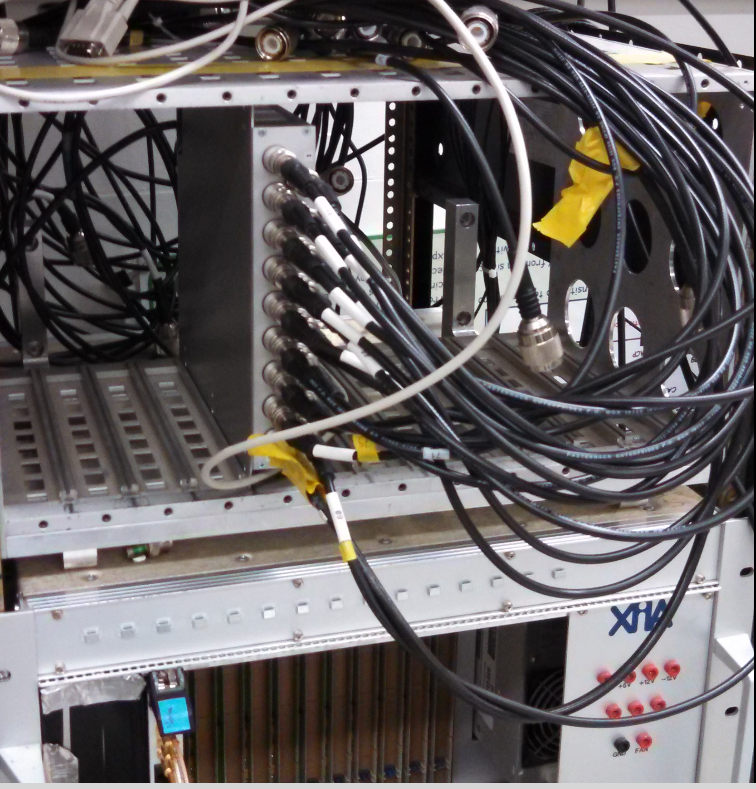
|
|
2
|
Fri Oct 31 11:36:57 2014 |
Alfredo Estrade | BRIKEN elog: take 2 |
A elog for the setup of the BRIKEN detector is now operational at https://elog.ph.ed.ac.uk/BRIKEN/
We have setup a list of emails that will receive automatic updates for each new entry to the logbook: C. Domingo, G. Lorusso, T. Davinson, A. Estrade, K. Rykaczewski, J.L. Tain, C. Griffin, S. Nishimura, I. Dillman, F. Montes, J. Agramunt, G. Cortes, F. Calvino, M. Marta
Please let us know the contact info for any other person that would like to be included in this list, or if you would like your email to be removed from it (should the new entries be too frequent for your inbox traffic!). |
|
1
|
Fri Oct 31 09:47:59 2014 |
Alfredo Estrade | BRIKEN elog: Hello world! |
A elog for the setup of the BRIKEN detector is now operational at https://elog.ph.ed.ac.uk/BRIKEN/
We have setup a list of emails that will receive automatic updates for each new entry to the elog:
C. Domingo, G. Lorusso, T. Davinson, A. Estrade, K. Rykaczewski, J.L. Tain, C. Griffin, S. Nishimura, I. Dillman, F. Montes, J. Agramunt, G. Cortes, F. Calvino, M. Marta
Please let us know about any other person that would like to be included in this list, or if you would like your email to be removed from it (should the new entries be too frequent for your inbox traffic!).
|